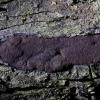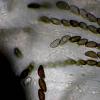
09-11-2025 13:20
Hello.A tiny ascomycete, appearing as erupting gra

08-11-2025 00:29
 Francois Guay
Francois Guay
I found this species in Quebec, Canada, on herbace

04-11-2025 09:07
Hello.A suspected Hymenoscyphus sprouting on a thi

04-11-2025 12:43
 Edvin Johannesen
Edvin Johannesen
Hi! One more found on old Populus tremula log in O

03-11-2025 21:34
 Edvin Johannesen
Edvin Johannesen
These tiny (0.4-0.5 mm diam.), whitish, short-stip
Hypoxylon petriniae ?
Thierry Blondelle,
12-03-2023 10:11
 Hello !
Hello !I'm a new member from France.
I require your advise for this sample of Hypoxylon found on a dead branch of Fraxinus.
I think to H. petriniae with these inconspicuous perithecal mouds.
Ascospores: 12-10 x 4-5 µm with double guttula in most of them.
Thanks
Thierry Blondelle
Lothar Krieglsteiner,
12-03-2023 10:21

Re : Hypoxylon petriniae ?
Hello Thierry,
can you tell us which color the pigment extracted with 10% KOH has?
Yours, Lothar
can you tell us which color the pigment extracted with 10% KOH has?
Yours, Lothar
Thierry Blondelle,
12-03-2023 10:39
Jacques Fournier,
12-03-2023 15:53

Re : Hypoxylon petriniae ?
Hi Thierry,
you are likely right, but H. petriniae may be highly variable in colour and external appearence, making its identification sometimes challenging.
A good discriminating character from other species with orange pigments is the relatively weak thickness of the stromata, rarely over 0.5 mm thick, combined ith the small diameter of perithecia, mostly 0.3-0.4 mm diam.
Cheers,
Jacques
you are likely right, but H. petriniae may be highly variable in colour and external appearence, making its identification sometimes challenging.
A good discriminating character from other species with orange pigments is the relatively weak thickness of the stromata, rarely over 0.5 mm thick, combined ith the small diameter of perithecia, mostly 0.3-0.4 mm diam.
Cheers,
Jacques
Thierry Blondelle,
12-03-2023 18:06

Re : Hypoxylon petriniae ?
Thanks Jacques for these additionnal informations.



